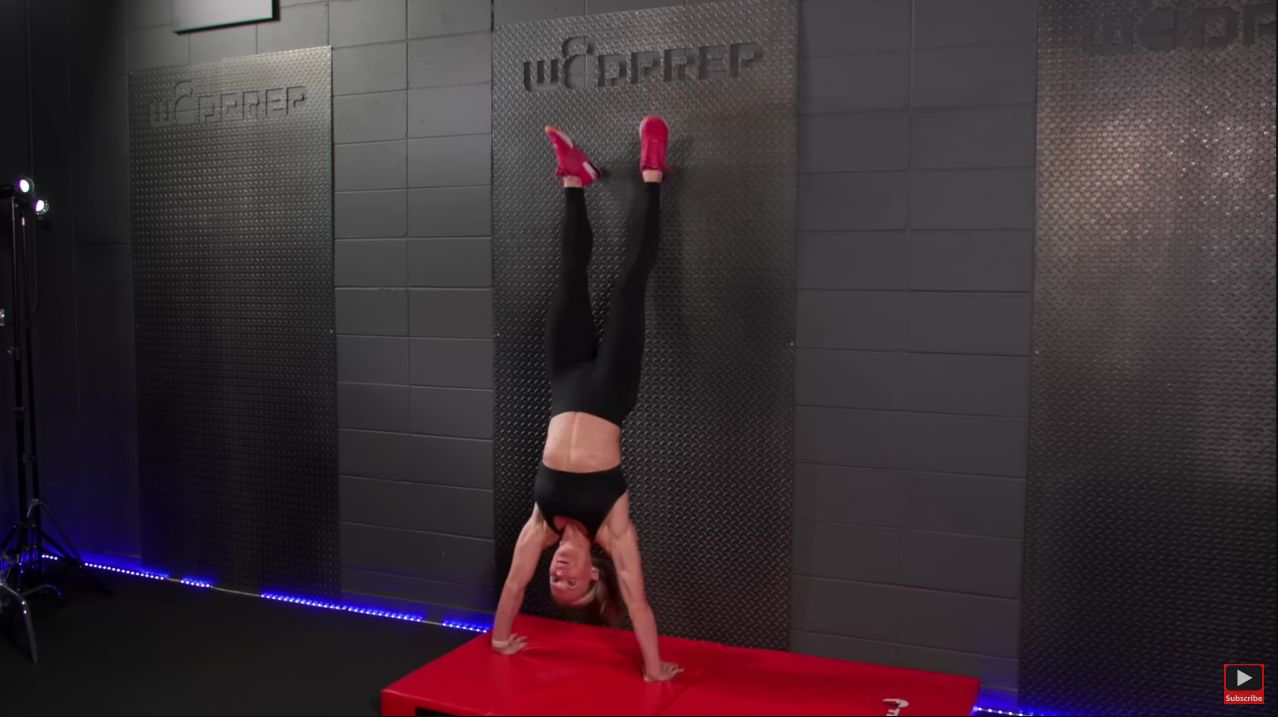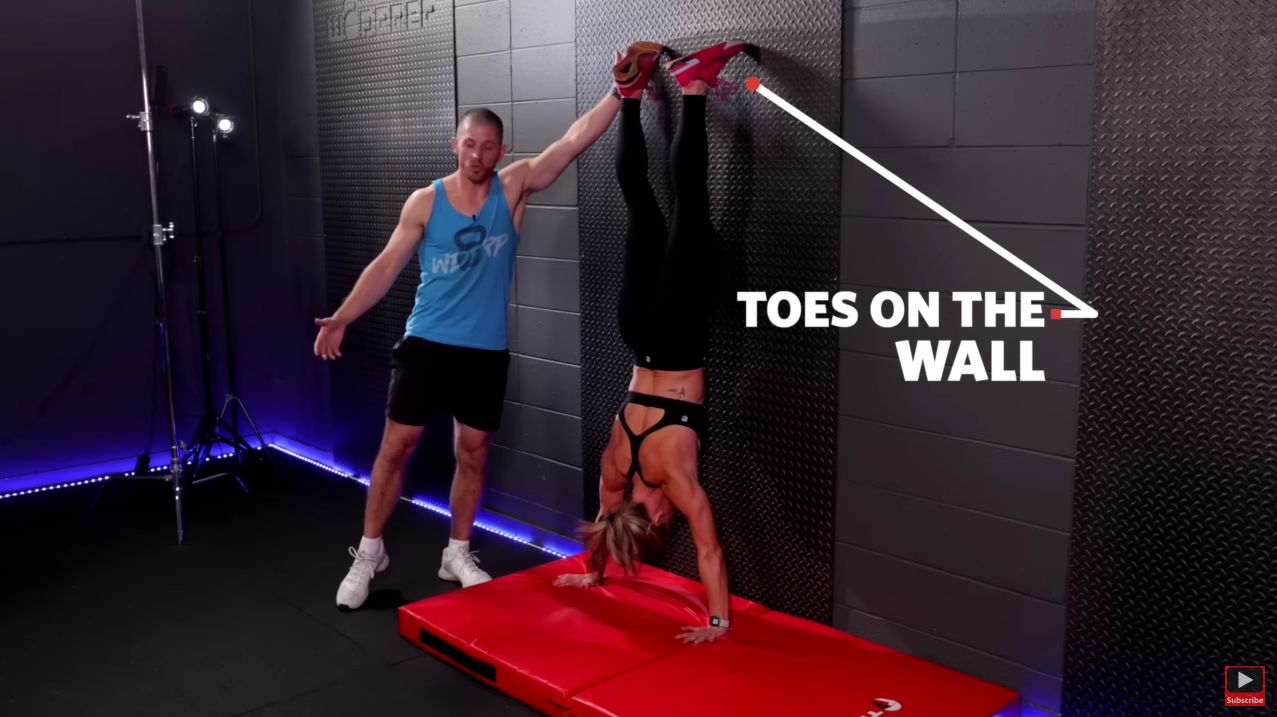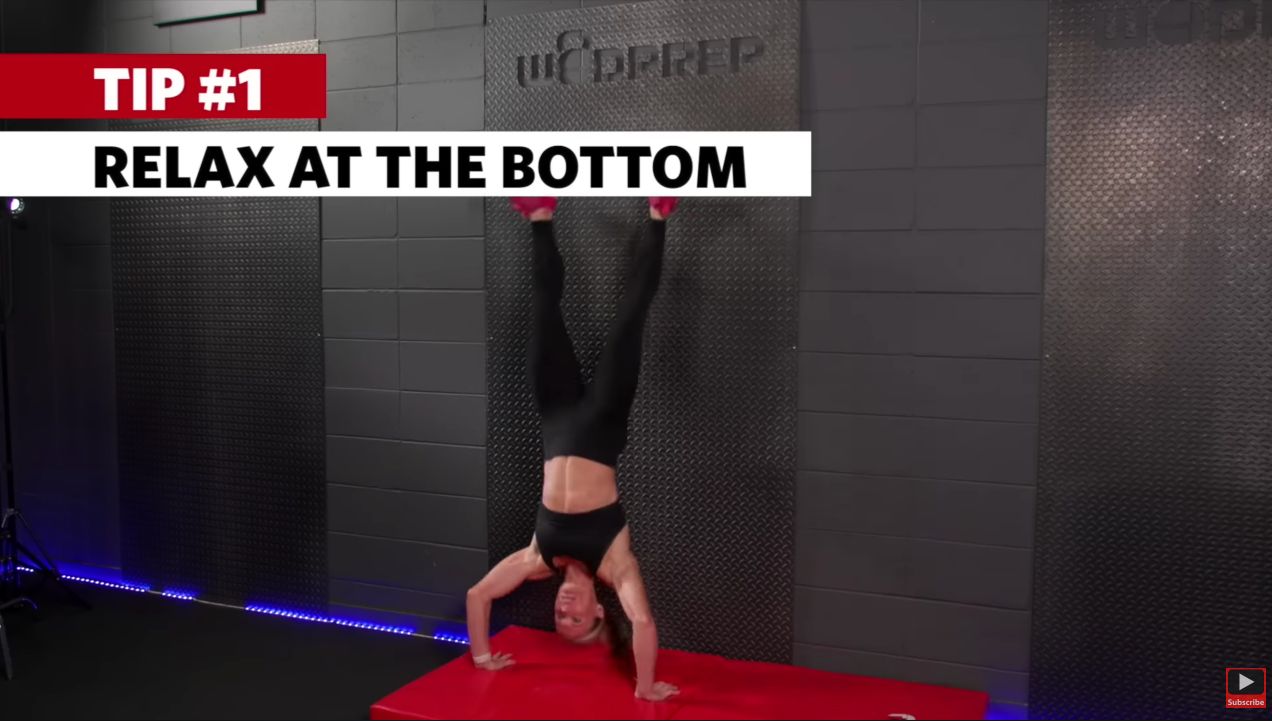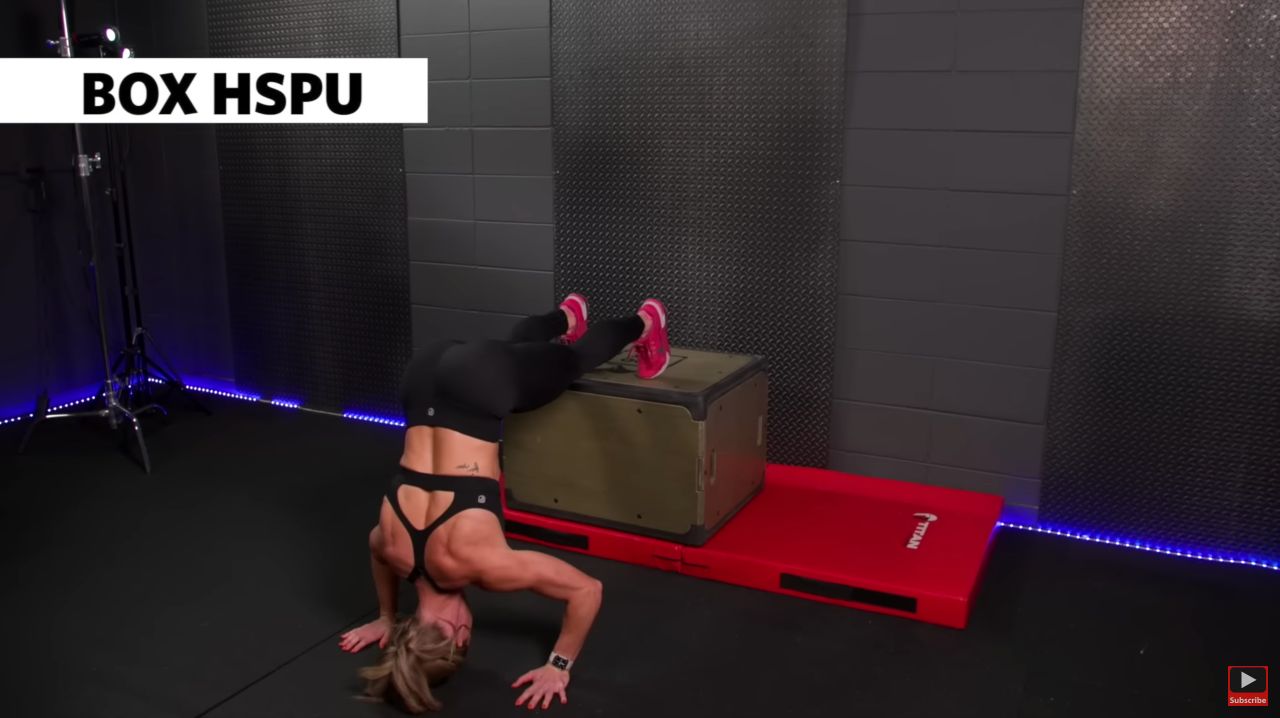Do you want to master the handstand push up? Strict, Kipping, Wall Facing, Deficit, Scaled... We've got you covered!
In this article, I will discuss the movement standards, points of performance, and tips on getting better at both strict and kipping handstand push ups so you can take your HSPU game to the next level.
The Standards
The first standard of the kipping up the wall movement is to kick up, your arms need to be extended and with your heels on the wall.
You need to touch your head to the ground and do whatever push up you want, back up and relax.
What I see a lot of times, and I know I've done it before, is when you kick up, you go into that first rep before actually getting that complete lockout and heels on the wall.
I've seen people who start at the bottom, but that's actually a no-rep.
You need to come all the way up and go back down before that first rep even starts; you have to make sure that your head is making contact at or below where your hands are.
A common problem is that people may put a pad underneath their head, but their hands aren't on it.
Technically you're actually reducing the range of motion, and that's not a full standard RX handstand push up.
We'll talk about that a little bit later when we get to my scaling tip.
So far, we've seen strict handstand push ups, and normally your heels stay on the wall the whole time.

But the standard of just a normal handstand push up is that you are allowed to kip, which means your feet are allowed to come off the wall.
The only standard for a handstand push up is to start locked out with your arms, heels on the wall, and head touching the ground, and then you end fully locked out with your heels back on the wall.
For kipping reps, you are allowed to take your heels off the wall and have your butt on the wall, but when you explode back up, only your heels are allowed to touch the wall.
The last thing to talk about when it comes to the standards and points of performance is you need to pay attention to your hand width.
The standards seem to change every single year during the CrossFit Open, and I've seen it in a bunch of different competitions.
But the most recent or most recognized standard is that the width of your hands needs to be within 40 inches of width and 24 inches of depth.
For example, if I kick up on the wall on a 36 inch wide mat, and I'm only used to doing handstand push ups with my hands, and it isn't that wide, it shortens the range of motion.
But technically, I will be practicing a handstand push up that's not really to the standard, so something important to note.
So those are the standards; it starts with a lockout and finishes with a lockout.
The Wall Facing HSPU
We have to mention a new version of the handstand push up that's crept up recently, thanks to the 2020 CrossFit Games, and that is the wall facing handstand push up.
Think of it as a strict handstand push up, but you're flipped around to face the wall.
To start this movement, you can kick up the wall or wall walk up.
But the standard here is now toes are on the wall, and nothing else can be touching the wall.
Do your rep and then come down however you like.
One way that might feel more comfortable for some people is simply doing a wall walk, getting your hands close to that wall, and then you could go straight into those reps.
They're just trying to make sure that your toes are on the wall.
The Deficit HSPU
Another version of the handstand push up that you might have seen is something called a deficit handstand push up.
All the same rules apply for the strict, kipping, wall facing, or whatever version you're doing.
All a deficit handstand pushup does is lower the target for your noggin.
So your head will actually hit below where your hands are.
All that's happening there is lowering the target for your head, which increases the range of motion and makes it harder.

The Strict HSPU
Now let's dig into the nitty gritty about the strict handstand pushup, and I'm going to give you a couple of tips to help you improve your performance.
I think the biggest and most important aspect of strict handstand push ups is to touch and go at the bottom.
Something I see a lot of athletes do where they relax at the bottom of the rep, but they don't realize that they're losing tension in their shoulders.
When you do strict handstand push ups, if you relax with your head on the floor, you're losing all of the tension in your shoulders to get you out of the bottom.
But many athletes cannot and will not generate enough tension and strength to actually get back out of the bottom.
The only way for them to do strict handstand push ups is to do what I call the touch and go or the tap and go.
And that's where you're not pausing at the bottom at all. In fact, you might even be rebounding a little bit.
You won't be bouncing your head on the bottom, but your head will touch and immediately go back up.
A common thing for many people doing strict handstand push-ups is they'll go down and then, on the way up, they're looking down at the ground.
So when you're doing your strict handstand push ups, I really want you to think. If you ever are having a hard time locking out, I will yell this to athletes when I see them doing this; I say, 'head through,' and what happens is that awkward lockout, where we can't quite get things figured out.
If I think about driving my head through, naturally, my arms and shoulders will stack in a really good position.
I assure you that if you're struggling with that lockout, a lot of times, if you just get that head neutral and look through the window, it's going to help you lock out very quickly, and you're going to feel much more stable and strong.
The Kipping HSPU
Now let's talk about the kipping handstand push up.
So a couple of the tips I just mentioned go entirely out the window.
The main thing is at the bottom of a kipping handstand push up; relaxing is okay. It's actually okay to lose that tension.
Because of the kip, that leg and the hip extension will pull you out of the bottom.
So at the bottom, your butt is on the wall, and your hands and head are in this nice tripod position.
Then your knees come below parallel like if you were squatting and your knees are below parallel.
If you are getting tired in the shoulders, you can pull your legs even lower and kick up.
Let's say you are deep into a workout, your shoulders are super fatigued, you can barely get your lockout, or maybe it's a bigger set you need to do.
You can start more aggressive kipping to create more momentum to help, and adjust the speed and aggressiveness of your kip, depending on the size of the set or how tired your shoulders are.
The last thing about kipping handstand push ups and making them a little easier is paying attention to where your hand positioning is.

If you're too close to the wall, when you do that hip extension, your butt actually hits a wall and bucks you off of it.
If you're too far away from the wall. You're making it much harder to do handstand push ups and putting your body in a really awkward position so it's hard to get a lockout.
So you have to play around with your happy medium.
For me, I'm a little bit farther away from the wall; it could be because I have a bigger booty.
My hands are probably a hand and a half away from the wall, so you might need to experiment for yourself.
You might be too close if you find yourself getting pushed away from the wall a lot.
If you feel like you're falling into the wall and not very balanced, you might have your hands too far away on your setup.
Scaling
Now it's time to talk about how to scale and modify your handstand push ups, so you can eventually work your way up to your RX level and beyond.
So first, let's talk about reps. Let's say you have a workout like Diane 2159 of deadlifts and handstand push ups, and 2159 that's 45 reps, is too many handstand push ups.
But you can do RX handstand push ups; what you could do is you could cut the reps of the handstand push ups in half, so instead of doing an RX Diane, or doing a Diane where you modify your handstand push ups to one of the scales, you could keep your RX handstand push ups but just cut the number in half.
So rather than 21, you could do 12, reducing the rep but keeping the standard of handstand push ups.
I liked that for highly skilled movements like this and things like muscle ups, keep the actual RX movement, reduce the reps and then get good fatigued exposure to getting RX reps of that movement.
That's scaling reps, now, scaling ROM is a very obvious, easy and very effective way to do handstand push ups.
So to scale ROM, that means range of motion, all I'm going to do is reduce the range of motion needed to do the handstand push up, I can simply add a block or a pad underneath my head.
One of my favorite ways to scale any movement is to simply reduce the head target or the range of motion of the handstand push ups
For people who have never even come close to doing handstand push-ups, I can get an athlete into position and get them doing scaled handstand push-ups pretty easily by using this technique.

Another way we can help develop strength in those muscles, so the shoulders, the core stability, everything, is you can remove the scaled range of motion and do something that I call negatives.
So this is where I'll have the athlete kick up; they get into position and then with control; it's very important that they do this with control, so we don't have any broken necks.
Once you're doing the handstand, wait three or four seconds, lower yourself down, let your head touch and relax.
You need to be just slow and controlled when you're going all the way down, and then as soon as that head touches, you let your feet drop.
Here's an excellent scaling option for people who aren't ready to get up on the wall.
Maybe the reduced range of motion or the negatives for the handstand push ups are just not quite there; what I will do is I will still have that athlete working on the wall, but I'll just take a box and do a box handstand push up.
So all you're gonna do is get your toes on the box, and then you're trying to get your torso in the most vertical position possible to simulate being on the wall.
And then from there, doing strict handstand push ups.
Another way you could scale is to make the box taller; the taller the box the harder the scale, and the same thing if the shorter the box; if you had the box on the 20-inch side, or even lower, it's going to be an easier handstand push up modification.
So one of the final modifications that I love for handstand push ups, and this is great for athletes who might not be comfortable kicking up on the wall, but need to develop the overhead strength to be able to get up on the wall and do handstand push ups and that's the seated dumbbell press.
What you're going to do is press up, and lock it out.
When you come down, have your elbows in, and then try to simulate that tripod position, and then straight up.
This is just a great shoulder-strengthening exercise that you can do to develop handstand pushup strength.
To Summarize
Whether you're a beginner or an experienced CrossFitter, mastering the handstand push up is possible with dedication and attention to detail.
I hope you enjoyed this article as we discussed movement standards, points of performance, and tips on improving strict and kipping variations.
With these tips in mind and practice to reinforce them, you can take your HSPU skills to a whole new level!
I have loads of videos on YouTube to go with this article that talks about how to develop handstand push ups strength, super in depth detailed videos about kipping, and strict all that good stuff.
If you want a free video tutorial, this is like a step-by-step mini-course that I created. I want to give it to you for free.
It's called The Ultimate Guide to Handstand Push Ups, and all you have to do is click here, enter your name and email and I will send you that video completely free.
After you submit your name and email, you will be offered an offer to join our full-fledged handstand push up power course, with all the top coaching I have to teach handstand push-ups, including programming.
Good luck!
